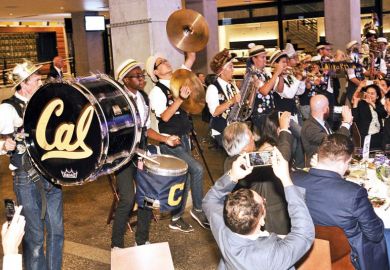Higher education needs to be less internally focused and concentrate on pivoting to meet the changing demands of students and society, according to Arizona State University president Michael Crow.
Professor Crow told Times Higher Education’s World Academic Summit that the “antiquated” model of the public research university “has very little utility going forward” in the US, hence his institution’s massive investment in online education.
He said ASU appeared to be the “only crazy people” that had responded to a national request in the US to train more engineers from a diverse background. The institution revamped its engineering department, Professor Crow said, and increased the number of engineering students – both in-person and online – from 6,000 to 30,500, and is aiming for 45,000 eventually.
“That’s what we think certain universities need to do, to be able to move forward at scale,” he said. “When we do that, we are roundly and summarily criticised because nothing big can ever be considered to be any good. Well, we’re going to show them, one way or another.
“Universities can’t sit in isolation. That’s hard because there is an intense interest among many faculty to be more internally focused.”
Professor Crow said most universities “come from a deep 2,400-year-old culture going back to Plato’s Republic of deep internal focus, faculty centrism”.
“There’s nothing wrong with that. But some universities have to take that same faculty, that same idea of academic freedom and then plug themselves into attaining what the country or region needs to attain.”
Speaking on the same panel, Darleen Opfer, vice-president and director of education and labour at the Rand Corporation, agreed. She said that the vast majority of higher education institutions were not global but very focused on their local geographic area, but too many were slow to respond to the needs of local communities.
“They are not meeting student needs, they are not meeting the needs of their communities for whatever reason, they are just not embedded enough,” she said.
As an example, Ms Opfer said, following the development of the gas industry in the Appalachian region of the US, community colleges took 10 years to only just start offering training in this area.
“All this time the gas companies have been importing labour in a region with high unemployment. [They are] just not being connected or responsive enough to what’s happening on the ground in [their] context and then not changing to meet that demand.”
Professor Crow said all colleges and universities should also be involved in research and offering scholarships, but this remains the domain of only the top institutions.
“Everybody should be involved but we don’t have that right now. The system is completely elitist and completely driven by valorisation, which gets us nowhere,” he said.
Register to continue
Why register?
- Registration is free and only takes a moment
- Once registered, you can read 3 articles a month
- Sign up for our newsletter
Subscribe
Or subscribe for unlimited access to:
- Unlimited access to news, views, insights & reviews
- Digital editions
- Digital access to THE’s university and college rankings analysis
Already registered or a current subscriber?









